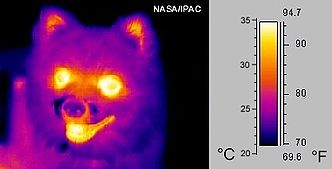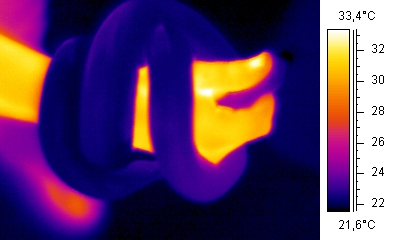Thermographic camera
This article does not cite any sources. (January 2009) (Learn how and when to remove this template message) |

A thermographic camera, sometimes called a FLIR (Forward Looking InfraRed), or an infrared camera less specifically, is a device that forms an image using infrared radiation, similar to a common camera that forms an image using visible light. Instead of the 450–750 nanometer range of the visible light camera, infrared cameras operate in wavelengths as long as 14,000 nm (14 µm).
Theory of operation
Infrared energy is just one part of the electromagnetic spectrum that encompasses radiation from gamma rays, x-rays, ultra violet, a thin region of visible light, infrared, terahertz waves, microwaves, and radio waves. These are all related and differentiated in the length of their wave (wavelength). All objects emit a certain amount of black body radiation as a function of their temperatures. Generally speaking, the higher an object's temperature is, the more infrared radiation as black-body radiation it emits. A special camera can detect this radiation in a way similar to an ordinary camera does visible light. It works even in total darkness because ambient light level does not matter. This makes it useful for rescue operations in smoke-filled buildings and underground.
Images from infrared cameras tend to be monochromatic because the cameras are generally designed with only a single type of sensor responding to single wavelength range of infrared radiation. Color cameras require a more complex construction to differentiate wavelength and color has less meaning outside of the normal visible spectrum because the differing wavelengths do not map uniformly into the system of color vision used by humans. Sometimes these monochromatic images are displayed in pseudo-color, where changes in color are used rather than changes in intensity to display changes in the signal. This is useful because although humans have much greater dynamic range in intensity detection than color overall, the ability to see fine intensity differences in bright areas is fairly limited. This technique is called density slicing.
For use in temperature measurement the brightest (warmest) parts of the image are customarily colored white, intermediate temperatures reds and yellows, and the dimmest (coolest) parts blue. A scale should be shown next to a false color image to relate colors to temperatures. Their resolution is considerably lower than of optical cameras, mostly only 160x120 or 320x240 pixels. Thermographic cameras are much more expensive than their visible-spectrum counterparts, and higher-end models are often deemed as dual-use and export-restricted.
Thermal imaging photography finds many other uses. For example, firefighters use it to see through smoke, find persons, and localize hotspots of fires. With thermal imaging, power line maintenance technicians locate overheating joints and parts, a telltale sign of their failure, to eliminate potential hazards. Where thermal insulation becomes faulty, building construction technicians can see heat leaks to improve the efficiencies of cooling or heating air-conditioning. Thermal imaging cameras are also installed in some luxury cars to aid the driver, the first being the 2000 Cadillac DeVille. Some physiological activities, particularly responses, in human beings and other warm-blooded animals can also be monitored with thermographic imaging. Cooled infrared cameras can also be found at most major astronomy research telescopes.

Types
Thermographic cameras can be broadly divided into two types: those with cooled infrared image detectors and those with uncooled detectors.
Cooled infrared detectors
Cooled detectors are typically contained in a vacuum-sealed case or flask and cryogenically cooled. This greatly increases their sensitivity since their own temperatures are much lower than that of the objects from which they are meant to detect radiation. Typical cooling temperatures range from 4 K to 110 K, 80 K to 90 K being the most common. Without cooling, these sensors (which detect and convert light in much the same way as common digital cameras, but are made of different materials) would be 'blinded' or flooded by their own radiation. The drawbacks of cooled infrared cameras are that they are expensive both to produce and to run. Cooling and evacuating are power- and time-consuming. The camera may need several minutes to cool down before it can begin working. Although the components that lower temperature and pressure are generally bulky and expensive, cooled infrared cameras provide superior image quality compared to uncooled ones. One approach is to use high pressure nitrogen cleaned to a very high standard (white spot 6-> 7 equivalent). The pressurised gas is expanded via a micro-sized orifice and passed over a miniature heat exchanger resulting in regenerative cooling via the Joule Thomson effect of the expanding gas cooling & heat exchanger combination. It is not difficult to imagine the cost of creating, storing and deploying such a system.
Materials used for infrared detection include liquid helium cooled silicon bolometers, and a wide range of cheaper narrow gap semiconductor devices including:
In principle, superconducting tunneling junction devices could be used as well as infrared sensors because of their very narrow gap. Small arrays have been demonstrated. Their wide range use is difficult because their high sensitivity requires careful shielding from the background radiation.
Uncooled infrared detectors
Uncooled thermal cameras use a sensor operating at ambient temperature, or a sensor stabilized at a temperature close to ambient using small temperature control elements. Modern uncooled detectors all use sensors that work by the change of resistance, voltage or current when heated by infrared radiation. These changes are then measured and compared to the values at the operating temperature of the sensor. Uncooled infrared sensors can be stabilized to an operating temperature to reduce image noise, but they are not cooled to low temperatures and do not require bulky, expensive cryogenic coolers. This makes infrared cameras smaller and less costly. However, their resolution and image quality tend to be lower than cooled detectors. This is due to difference in their fabricational processes, limited by currently available technology.
Uncooled detectors are mostly based on pyroelectric and ferroelectric materials [1] or microbolometer technology.
Some of the materials used for the sensor arrays are eg.: [2]
- vanadium(V) oxide (metal insulator phase change material, for microbolometer arrays)
- lanthanum barium manganite (LBMO, metal insulator phase change material)
- amorphous silicon
- lead zirconate titanate (PZT)
- lanthanum doped lead zirconate titanate (PLZT)
- lead scandium tantalate (PST)
- lead lanthanum titanate (PLT)
- lead titanate (PT)
- lead zinc niobate (PZN)
- lead strontium titanate (PSrT)
- barium strontium titanate (BST)
- barium titanate (BT)
- antimony sulfoiodide (SbSI)
- polyvinylidene difluoride (PVDF)
Thermographer training
Aside from test equipment, training is the most important investment a company will make in an infrared inspection program. Advances in technology have provided infrared equipment that is user-friendly; however, infrared thermography is not a "simply point and shoot" technology. In addition to understanding the object or system being inspected, thermographers must also understand common error sources that can influence observed thermal data. Typically, infrared training courses should cover the topics of infrared theory, heat transfer concepts, equipment selection and operation, how to eliminate or overcome common error sources, and specific applications. Home and business owners who attempt thermal imaging themselves, in an effort the improve home energy efficiency, often misinterpret the images and may be prompted to spend on unnecessary improvements. Structural thermal imaging professionals can properly interpret readings and recommend cost-effective measures to improve building efficiency.
Applications
Originally developed for military use during the Korean War, thermographic cameras have slowly migrated into other fields as varied as medicine and archeology. More recently, the lowering of prices have helped fuel the adoption of infrared viewing technology. Advanced optics and sophisticated software interfaces continue to enhance the versatility of IR cameras.
- Astronomy, in devices such as the Spitzer Space Telescope
- Night vision
- Firefighting operations
- Military & Police target detection & acquisition
- Law enforcement and anti-terrorism
- Predictive maintenance (early failure warning) on mechanical & electrical equipment
- Process monitoring
- Condition monitoring & surveillance
- Automotive applications
- Energy auditing of building insulation and detection of refrigerant leaks
- Roof inspection
- Auditing of acoustic insulation for sound reduction
- Masonry wall structural analysis
- Moisture detection in walls & roofs (and thus in turn often part of mold remediation)
- Chemical imaging
- Medical testing for diagnosis
- Nondestructive testing
- Quality control in production environments
- Research & development of new products
- Pollution effluent detection
- Locating unmarked graves
- Aerial archaeology
- Paranormal investigation
- Search and rescue operations
- Technical Surveillance Counter-Measures
- Quarantine monitoring of visitors to a country
- Flame detector
Specifications
Some specification parameters of an infrared camera system are:
- Number of pixels
- Spectral band
- Sensor life time
- Minimum resolvable temperature difference (MRTD)
- Field of view
- Dynamic range
- Input power
- Mass and volume
See also
Template:Commons cat Template:Commons cat
- Digital infrared thermal imaging in health care
- Thermography
- Infrared photography
- Thermal imaging camera
ca:Càmera tèrmica de:Thermografiekamera nl:Infraroodcamera fi:Lämpökamera